Lasers and the Universe
From in silico laser-driven QED cascades to neutron star pair plasmas (IST, Portugal)
Laser intensities approaching 1024 W/cm2 have already been achieved, and facilities worldwide aim to achieve even higher intensities in the future. At these intensities, novel effects driven by quantum electrodynamics (QED) start to be important. Many scientists, including several Laserlab-Europe partners, are working to determine the optimal conditions for producing pair plasmas or gamma rays, and exploring laser configurations that can trigger QED processes (for instance, conversion of gamma-ray photons into cascades of electron-positron pairs). Besides addressing fundamental questions at the interface of laser physics, QED, and plasma physics, these secondary sources have highly relevant applications in materials science, biology, and medicine. The scientific pursuit of these extreme regimes has triggered fundamental advances in the theory of ultra-high-intensity laser physics, and in the development of novel kinetic models that exploit high- performance computing to capture the multidimensional, many-body physics, strong field QED, collective plasma dynamics, and radiation (Figure 1).
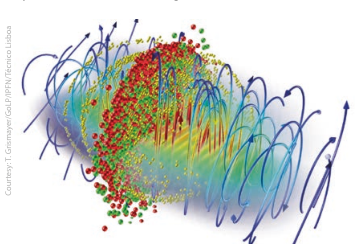
Figure 1: 3D particle-in-cell simulation snapshot of QED cascades in a rotating electric laser field generated by two counter-propagating laser pulses. The laser pulses are shown through isocon-tours of the electromagnetic energy. The electrons, positrons and photons are represented in red, green and yellow, respectively.
Delivering the focused intensities required to drive QED cascades in the laboratory will allow the complex interplay between QED and plasma physics to be probed. This interplay is pervasive in some of the most extreme events in the Universe, for example in the polar caps of neutron stars. Electrons that are strongly accelerated in vacuum gaps can radiate in the ultra-strong magnetic fields and generate gamma rays, which in turn generate more electrons (and positrons), thus driving cascades of electron–positron pairs. Scientists at Instituto Superior Tecnico, Lisbon, Portugal, supported by the European Research Council, have been exploring these astrophysical scenarios, using the same tools that have been used to explore high-intensity laser-plasma interactions, and leveraging what has been learned from such interactions.
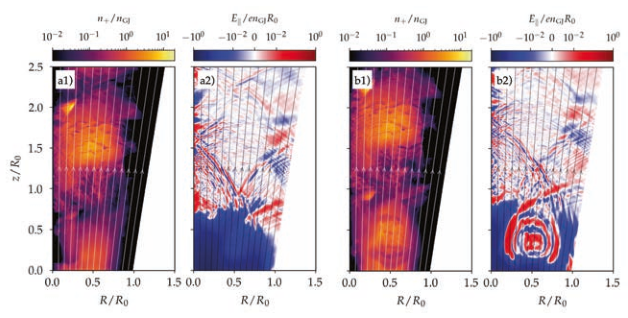
Figure 2: Two-dimensional simulation of a pulsar polar cap, showing the self-consistent excitation of plasma waves during a QED cascade. The panels show (1) the plasma density and (2) the electric field at times just before (a) and during (b) a QED cascade. The horizontal axis (R/R0) is aligned with the star radius, while the vertical axis (z/R0) is aligned with the axis of rotation of the pulsar. Courtesy: F. Cruz/GoLP/IPFN/Técnico Lisboa
Their ab initio simulations, conducted in collaboration with researchers at Princeton University, have recently been published in the Astrophysical Journal Letters [1], and demonstrate how coherent radiation (in the radio regime) can be generated by the cyclic production of pair plasmas in QED cascades. Many of the relevant physical processes share the same underlying physics as laser-matter interactions in the QED regime, and scientists are now exploring the possibility of mimicking these extreme scenarios in the laboratory with lasers, par- ticles beams, or a combination of the two.
Luis Oliveira e Silva, Fábio Cruz, Thomas Grismayer (GoLP/IPFN, IST)
[1] F. Cruz et al., The Astrophysical Journal Letters, 919: L4 (2021)
Infrared spectroscopy sheds light on the formation of complex organics in space (FELIX, the Netherlands)
Polycyclic aromatic hydrocarbons (PAHs) – in principle large molecules made up from fused benzenoid rings – are produced as toxic pollutants on Earth in combustion processes. In space, they are amongst the most complex organic molecules detected, representing a major reservoir for cosmic carbon, and yet their formation pathways in cold environments of the Universe remain elusive. Recent astronomical detections show that current astrochemical models drastically underestimate the abundance of aromatic molecules in cold molecular clouds. These molecular clouds are the birthplaces of new stars and planets, and the detailed study of their chemistry will provide astronomers with a better understanding of the process of star and planet formation.
Researchers at HFML-FELIX have provided novel exper- imental evidence for alternative formation routes of PAHs in cold environments of the Universe. The team set out to study a specific class of reactions, those between a cationic and a neutral molecule. In a pathfinder study, they investigated the reaction of the monocyclic pyridine cation with neutral acetylene (C2H2). A cold ion-trap instrument, stationed at one of the FELIX end stations and developed in collaboration with Prof. S. Schlemmer, University of Cologne, was used to mimic the cold and dilute conditions of molecular clouds. Mass-spectrometry studies showed that larger molecules, with masses corresponding to two added acetylene units, were indeed efficiently formed. However, by only detecting the mass of a certain molecule, no information on its structure could be obtained, to prove that the product was indeed a PAH, and not just a pyridine with some dangling acetylene units.
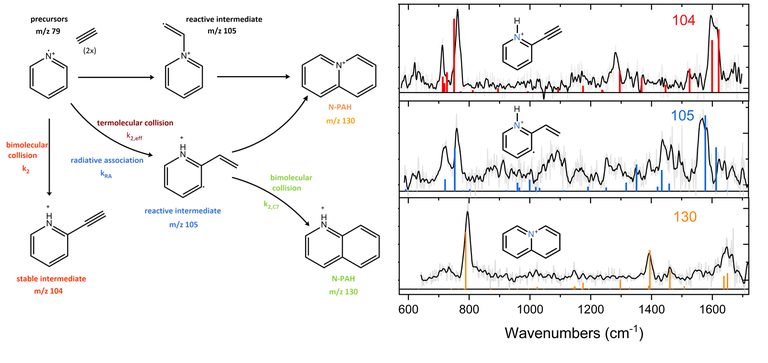
Schematic reaction scheme from monocyclic pyridine radical cation to the polycyclic quinolizinium (left), as elucidated by FELIX infrared spectroscopy of the reaction intermediates and the finalproduct (right).
By combining their low-temperature kinetic studies with in situ infrared spectroscopic probing, using the FELIX free- electron laser, the team obtained unambiguous experimental proof of the formation of the polycyclic quinolizinium from a monocyclic precursor. Furthermore, spectroscopic identification of reaction intermediates allowed competing formation pathways to be disentangled, providing information beyond purely mass-spectrometry and computational studies. The observed quinolizinium belongs to an astronomically interesting, but experimentally little studied, class of PAHs. The spectroscopic data obtained can thus act as a basis for future astronomical observations aimed at unravelling the formation of PAHs in space, for example with the recently launched James Webb Space Telescope.
Daniël B. Rap, Johanna G.M. Schrauwen, Aravindh N. Marimuthu, Britta Redlich, Sandra Brünken
D.B. Rap et al., Nature Astronomy 6: 1059–1067 (2022)
Boosting meteorite mass spectrometry with lasers (ILC, Slovakia)
Combining advanced surface characterisation techniques with state-of-the-art laser technology lies at the forefront of current research in areas such as material science and condensed matter physics. The International Laser Centre in Bratislava successfully integrated a secondary ion mass spectrometer with a femtosecond laser to achieve adaptive control post-ionisation, delivering significantly enhanced capabilities for the characterisation of meteorites/micrometeorites.
Secondary ion mass spectrometry is a well-established analytical technique. A pulsed ion gun produces bunches of primary ions that sputter the sample surface, creating a phenomenon called collision cascade. The uppermost layers of the sample are thereby ionised, extracted and analysed in a high resolution mass spectrometer. The technique shows very high sensitivity (ppb), high mass resolution (m/Δm ~104), and, in principle, high spatial resolution (down to nm). As such, it is very suitable for a broad range of applications throughout material science, analytical chemistry, the semiconductor industry, and the life sciences. However, the technique is non-quantitative. The ion yield during the collision cascade is sensitive to the chemical environment of the sample surface, resulting in different secondary ion yields due to the so-called matrix effect. Moreover, the secondary ion yield is generally low, with less than 1% of the sputtered species being in an ionised form.
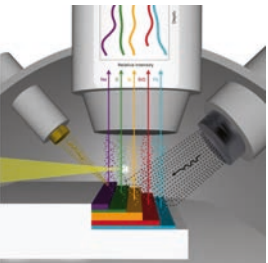
Schematic of the experimental set-up, showing post-ionisation above the sample surface
Yield can be improved by applying “post-ionisation,” i.e. externally delivering energy to the desorbed species and removing (ideally one) outer electron thereby turning the neutral atoms and molecules into ions. In the research part LaPoM2et, sponsored by the European Space Agency’s Plan for European Cooperating States, a commercially available time-of-flight secondary ion mass spectrometry (TOF-SIMS) apparatus (ION-TOF IV, Munster, Germany) was combined with a custom-built femto- second Cr:forsterite laser system. Ultrashort pulses (120 fs duration, 4 mJ energy) were focused inside the SIMS chamber to produce a beam waist approximately 250 μm above the sample surface. Here the desorbed, mostly neutral, species under- goes post-ionisation, and the ionised atoms/molecules are subsequently extracted by means of external bias for analysis by a TOF mass analyser.
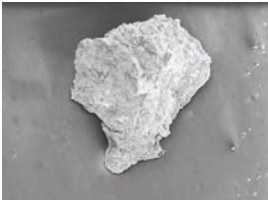
Small fragment of the Kosice meteorite
Sample mass spectra were derived for an ordi- nary class H5 chondrite metoerite, the parent body of which entered the atmosphere on 28th October 2010 near the town of Kosice in Eastern Slovakia. Besides the usual terrestrial contaminants CxHy, the standard SIMS spectrum shows characteristic elemental features (Mg, Ca, Si) that correspond to the composition of expected minerals, such as forsterite, enstatite, diopside, augite, etc. The post-ionised mass spectrum shows a simpler structure and lower mass resolution, but the peak intensities correspond to the relative abundance of elements within the sample, providing quantitative results. Future work will focus on improving post-ionisation mass analysis by the application of machine learning methods.
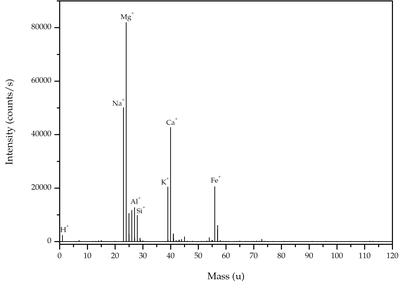
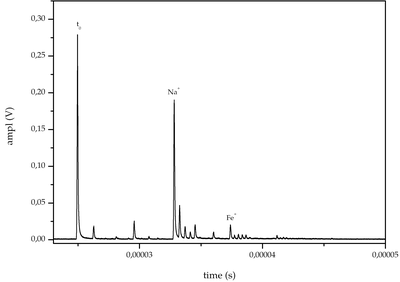
Standard (top) and post-ionised (bottom) mass spectra of the Kosice meteorite
Justina Novakova, Eva Noskovicova, Monika Jerigova, Dusan Lorenc and Dusan Velic (ILC)
Turning light into matter (CLF, United Kingdom)
A team led by Imperial College, London, and with strong participation from European Institutes and Universities, carried out an experiment in the Gemini facility at the Central Laser Facility at the STFC Rutherford Appleton Laboratory, in an attempt to prove an 88-year-old theory.
In 1934, using the then new theory of the interaction between light and matter known as quantum electrodynamics (QED), Gregory Breit and John Wheeler proposed a mechanism whereby light can be turned into matter under certain conditions. The Breit-Wheeler (BW) process involves smashing two photons together to create an electron and a positron. This process is widely believed to have been present during the first 100 seconds of the Universe and to be responsible for gamma-ray bursts, but has not been demonstrated experimentally, with past attempts requiring the addition of other high-energy particles. Prof. Steve Rose at Imperial College, London derived a method to demonstrate the process using only photons, which was tested in Gemini in 2018 by a team of physicists from Imperial College, Friedrich Schiller University Jena, and Queen’s University Belfast. Whilst the team is still analysing the results, details of the experiment were published a few months ago [1].
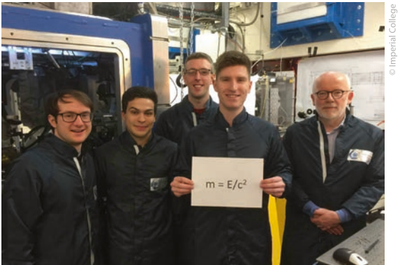
Experimentalists from Imperial College and the Friedrich Schiller University Jena
Two of Gemini’s high-power laser beams were used to create the photons of light to be smashed together. Photons from one beam contained about one thousand times the energy of photons that produce visible light, while those from the other beam contained some one billion times the energy. The beams were focused on two separate tiny targets inside a chamber that contained complex optics to focus the laser beams, and magnets to deflect the charged particles.
In the set-up used, a collimated beam of very high-en- ergy photons was fired through the cloud of x-ray photons emitted by a hot plasma, and the positrons produced in the collision were captured using a highly specialised detector. These charged positrons will confirm if the process was a success.
The experiment characterised the photon and electron beams, and recorded the positrons from the interaction as well as background levels. Careful data analysis is being carried out to determine whether the positrons can be confirmed as originating from the BW process, and not from other background processes. The team hopes that the method used could pave the way to observing the BW process using only photons, and provide statistically significant proof of light being turned into matter.
Rajeev Paramel Pattathil (CLF)
[1] B. Kettle et al., New J. Phys. 23: 115006 (2021)
Extreme laboratory astrophysics using high power lasers: from QED effects to gravitational waves (CELIA, France)
The advent of new multi-petawatt laser systems is opening up new pathways to extreme laboratory astrophysics. The first study presented here concerns the direct production of electron-positron pairs in photon collisions, one of the basic processes in the Universe. The linear Breit- Wheeler (BW) pair creation process (γ+γ′ to e++e-) controls the energy release in Gamma Ray Bursts (GRBs) and Active Galactic Nuclei. The BW process, with its important probability of matter creation, has never been clearly observed in the laboratory, because of the absence of the intense gamma ray sources.
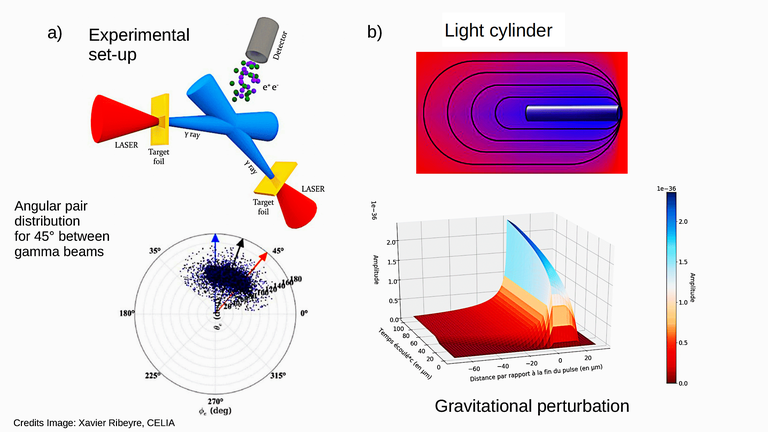
Recently, a team at CELIA [1] proposed a new experimental setup (Figure a, top) based on numerical simulations with QED effects (Figure a, bottom) to observe the process, involving the collision of two identical gamma photon beams in the MeV range. Colliding the beams in vacuum would enable production of a significant number of electron-positron pairs in a controllable way. A project (Turn Light Into Matter (TULIMA)), funded by the French National Research Agency ANR, is underway to optimise the gamma ray and electron-positron pair generation, with particular emphasis on the development of suitable detectors. Some 1 – 100 pairs per laser shot are predicted [2], making the experiment difficult, but high power lasers offer a unique way to observe and study the process in the laboratory.
The second study [3] is devoted to the influence of high power lasers on gravity. Gravitational waves, as first predicted by Einstein, have recently been detected on the LIGO-VIRGO interferometers and a new field of astronomy is emerging. The possibility of producing gravitational perturbations using high power laser beams is discussed, and a theoretically exact solution of general relativity for a light pulse modelled by a cylindrical shape (Figure b, top) is presented, with the solution for the perturbation provided (Figure b, bottom). The gravitational perturbation is small in the laboratory (of the order of ~10–36 amplitude for 1 PW), but several research groups have proposed new concepts for detecting such levels of perturbation, for example, by the delay induced on an atomic clock. Because general relativity concerns a lot of astrophysical phenomena, the theoretical results are also applied to GRBs. These phenomena produce very high energy and powerful gamma rays (1044 W), which deform the local space-time, and it may be possible to detect the perturbation during these extreme astrophysical events.
Xavier Ribeyre and Emmanuel d’Humières (CELIA)
[1] X. Ribeyre et al. Phys. Rev. E, 90: 013201 (2016)
[2] L. Esnault et al. Plasma Phys. and Cont. Fusion 63: 125015 (2021)
[3] P. Lageyre et al., Phys. Rev. D 10: 104052 (2022)
New laser beamline for laboratory planetary science at GSI (Germany)
Warm dense matter – matter with a temperature and pressure in the 1–10 eV and 1–100 Mbar ranges, respectively – pervades the interior of many astrophysical objects, such as planets, and understanding its properties is essential for planet modelling. Creating such states of matter in the laboratory is possible, but requires powerful drivers. Nanosecond-laser-based drivers have delivered many new results in the last decade, although there are indications that material properties might be different under laser-driven shock experiments and static conditions. For instance, the melting temperature of iron, which is essential to modelling the magnetic field properties of the Earth, differs in laser-driven experiments and static ones. Using heavy- ion beams as drivers – such as those that are available at Laserlab-Europe member GSI and that will be available at the future accelerator facility FAIR – is a complementary approach that offers much more uniform experimental conditions, both spatially and temporally, and therefore has the potential to deliver highly accurate measurements closer to thermodynamic equilibrium.
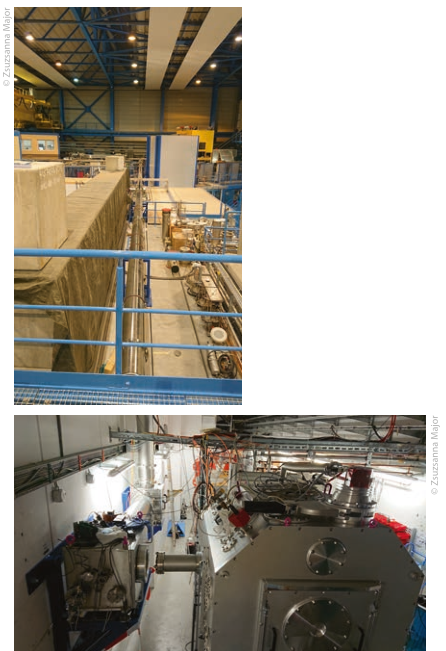
Figure 1: The newly commissioned PHELIX-HHT beamline. Top: the vacuum beamline for laser-beam transport traversing the experimental hall covering a distance of approx. 65 m between the PHELIX building and the HHT experimental area. Bottom: laser-beam transport and target chamber at HHT.
As part of the GSI infrastructure, the high-power laser PHELIX facilitates experiments combining the heavy-ion beam of the accelerator with high-energy laser pulses. PHELIX is a multi-100 J-class glass laser, operated as a Laserlab-Europe Access facility that has been open to the international scientific community since 2008 for combined laser-ion experiments. A new high-energy laser beamline has recently been added to the infrastructure, guiding PHELIX’s long-pulse beam to the HHT (high energy, high temperature) experimental area (Figure 1), downstream of the SIS-18 accelerator ring. High-energy laser pulses, with up to 200 J pulse energy at 1 ns pulse duration and 527 nm wavelength, are now available in the HHT area in addition to the high-intensity heavy-ion beam. In combined experiments, the heavy-ion beam acts as the driver and PHELIX as a powerful probe. The laser pulses are mostly used for driving x-ray sources that serve as diagnostic tools for warm dense matter generated by the ion beam. A series of commissioning experiments successfully demonstrated the temporal synchronisation of the laser and ion pulses in the HHT target chamber (Figure 2), and the use of the PHELIX pulse for x-ray-based diagnostics.
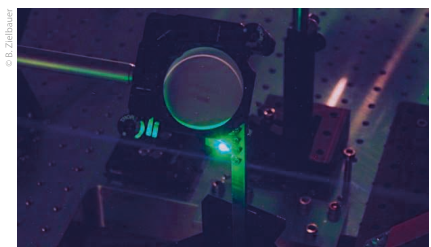
Figure 2: The heavy-ion beam and the high-energy laser together in the HHT target chamber. The photograph shows the PHELIX laser pulse focused onto a PTFE target (green), and the ion-beam-induced fluorescence in Ar visualising the path of the focused Xe beam (purple).
Experiments using this newly established experimental capability started this year, beginning with studies on iron and diamond under heavy-ion irradiation. This work paves the way for experiments in laboratory planetary science at FAIR, where ion beams of even higher intensity will be available, and will allow the HED@FAIR collaboration to fully realise its scientific programme.
Zsuzsanna Major and Vincent Bagnoud (GSI)
https://www.gsi.de/work/forschung/appamml/plasmaphysikphelix/hed_at_fair
Studying supernovae using high-power lasers (LULI, France)
Advances in laser technology have enabled the observa- tion of new phenomena in plasma physics, including the investigation of astrophysical objects in the laboratory setting, via the use of appropriate scaling laws. Recent experiments on LULI2000 at the Laboratoire pour l’Utilisation des Lasers Intenses (LULI) have focused on the study of supernova remnants and their interaction with the surrounding medium. When a star runs out of fuel and dies, the subsequent explosion causes a blast wave, known as a supernova remnant, which spreads out for thousands of years across vast distances. This situation can be replicated in the laboratory by focusing a long-pulse laser onto a small cylindrical target inside a gas-filled vacuum chamber. The resulting blast wave can then be studied in detail with an array of diagnostics. Researchers at LULI performed three experimental campaigns, each centred on understanding a different part of this process.
In the first of these experiments, a strong magnetic field was applied to the whole system using a Helmholtz coil and pulsed power system. When this field was applied, the blast wave became elongated along one direction. Despite computational models predicting that these remnants ought to be spherically symmetric, many telescopic images exhibit an elliptical shape. Many hypotheses exist to explain these observations, but up until now, it has been difficult to test them. These results support the idea that a large-scale magnetic field is present around many observed supernova [1].
The second experiment studied the collision of two separate remnants (see figure). The team probed background gas properties, such as electron density and temperature, in the interaction region between the two waves. By observing changes in the spectral lines, researchers found that the interaction creates a high-temperature zone, up to 20% hotter than the single blast wave case. The region remains at the elevated temperature long after the start of the interaction, thus strongly affecting the dynamics of the background medium [2].
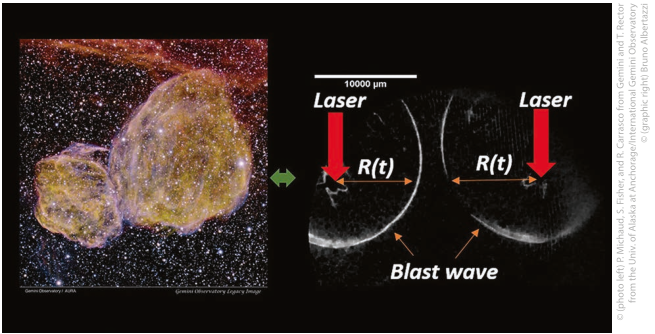
The collision of two interacting Taylor Sedov blast waves. Left: Two supernova remnants located in the Large Magellanic Cloud captured by the Gemini South Multi-Object Spectograph (GMOS). Right: Schlieren images of analogue experiment carried out at the LULI laser facility.
The final experiment investigated the interaction of a remnant with dense regions in the surrounding environment. Molecular clouds are collections of gas and dust in space. When left alone, these clouds remain in a state of peaceful equilibrium, but when triggered by some external agent, like a supernova remnant, shockwaves shoot through the gas and dust to create pockets of dense material. At a certain limit, that dense gas and dust collapses, and begins to form new stars. This process, known as triggered star formation, was replicated in the laboratory by placing a foam sphere of suitable density in the path of the expanding blast wave [3].
Future experiments are planned to reduce experimental error bars and thereby better constrain the as- trophysical models, and to combine some of the themes explored and introduce new themes, such as the role of turbulence.
Paul Mabey (Freie Universität Berlin)
[1] P. Mabey et al., ApJ 896: 167 (2020)
[2] B. Albertazzi et al., Physics of Plasmas 27: 022111 (2020)
[3] B. Albertazzi et al., Matter and Radiation at Extremes 7: 036902 (2022)

